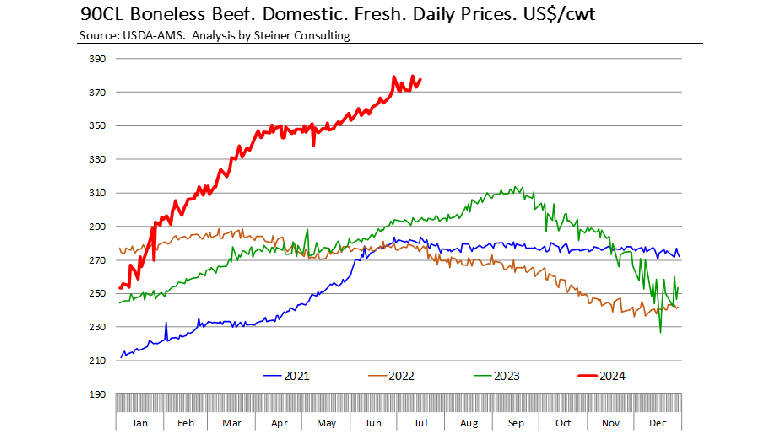Beef supply shortfall driving record wholesale and retail prices
Current prices are near the previous cyclical peak in 2014-15,

The supply of lean beef (cow meat) was expected to decline by double digits in 2024 due to the decline in cow inventories and a return to a more normal culling rate. But even those expecting a decline have been taken aback by the shortfall, and the resulting record wholesale and retail prices.
For all Q2, cow and bull slaughter averaged 16% below last year and almost 30% lower than two years ago. Making matters worse the supply of fed beef cuts that can go into ground beef is also down, a function of the steady decline in the calf crop in recent years. Higher prices are needed to ration out a smaller supply. As of this writing, the benchmark price for fresh, domestic lean grinding beef is trading at $3.75 a pound, 28% higher than a year ago. This is a new record high for this product. When adjusted for inflation, current prices are near the previous cyclical peak in 2014-15.
Retail ground beef prices have hit record high levels as well. According to the Bureau of Labor Statistics, the June average price for all types of ground beef sold at retail was $5.71 a pound, 5% higher than a year ago. Ground beef is by far the most common beef product consumed. It is estimated that 55% to 60% of all beef is consumed in ground form. In the near term, demand for ground beef is quite inelastic.
Retailers are careful not to raise prices too fast as it is a core item in many consumers’ baskets. By raising prices too fast, retailers risk losing sales to competitors. Given the recent trend in prices, however, retail prices are likely to continue to march higher into the fall. As for foodservice operators, much depends on the type of product offered. Those that offer products made only with fresh domestic beef have little choice but accept some margin compression or try to pass on the higher prices to consumers.
Foodservice operators are already facing significant headwinds due to higher labor costs and tighter consumer budgets. High prices for beef raw material only add to the extremely challenging environment. More imported lean beef is coming and currently trading as much as 20% below domestic product. This provides a significant advantage for quick-service concepts that can use imported product in their offerings and will likely result in more operators rethinking their formulations.
Looking for a reprint of this article?
From high-res PDFs to custom plaques, order your copy today!







